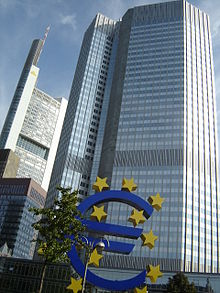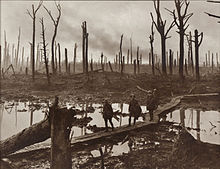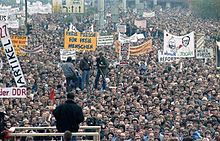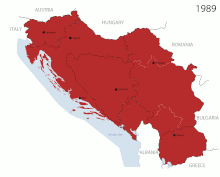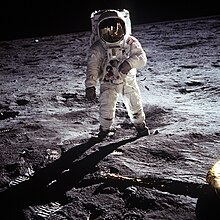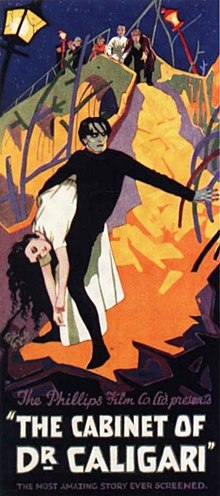20th century
Portal history | Portal Biographies | Current events | Annual calendar
◄ |
18th century |
19th century |
20th century
| 21st century
| 22nd century
1900s |
1910s |
1920s |
1930s |
1940s |
1950s |
1960s |
1970s |
1980s |
1990s
The 20th century began on January 1, 1901 and ended on December 31, 2000. In order not to allow the centennial celebration and the anniversary of the 30th anniversary of the founding of the Reich on January 18, 1901 to compete with each other, Kaiser Wilhelm II issued a different for Germany Decree that fixed the beginning of the new century on January 1st, 1900. The 20th century is part of the modern era and was particularly shaped by imperialism and the two world wars as well as the resulting decline of the European colonial empires and the Cold War , as well as by the exponential increase in world population, the automation and digitization of economic processes and the Polarization between the First and Third World. Important technologies like plastics , electronics , space travel and antibiotics changed the world.
historical overview
Periodization
Many historians do not use calendar divisions for their periodizations , but refer to political, social or cultural aspects when determining caesuras. The thesis of the " long 19th century ", which lasted until the beginning of the First World War (1914), is widespread . Linking the turning point with the October Revolution of 1917 is also a common thesis. At the same time, the 20th century is also known as the “ short 20th century ”, which lasts from the end of the First World War to the end of the Soviet Union and its sphere of influence from 1989 to 1991. The east-west conflict can be the basis for the periodization. It already had its roots in the rise of the labor movement in the 19th century. In the 20th century, many organizations tried to create new state organizations from the theories of Karl Marx and Friedrich Engels . This process began with the October Revolution of 1917 and ended with the collapse of the attempt known as “ Really Existing Socialism ” around 1990.
The pre-war period

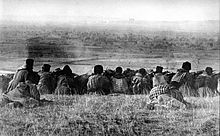
The ideas of the French Revolution (1789) had achieved a great deal and Napoleon Bonaparte completely reshaped the political map of Europe. The industrialization and the resulting capitalist societies had become established in the 19th century. The social question came to the fore and trade unions , social democratic parties and other organizations of the workers' movement developed. In response to this, welfare state reforms emerged in some industrialized countries, but also the expansion of democratic participation , such as the right to vote. Technical progress increased mobility and noticeably shortened communication routes through the railways and the first motor vehicles .
In Europe, completely different systems and regimes faced each other. In the United Kingdom and also in France functioning plural and liberal bourgeois democracies had prevailed, which arose with industrialization and the implementation of the capitalist mode of production. In Germany, on the other hand, there was a repressive authoritarian regime that suppressed its opponents and relied primarily on the military. The Russian tsarist empire was even more authoritarian, where the great misery of broad strata, the wealth of a small upper class and an ultra-repressive political regime confronted each other and caused corresponding discontent.
At the end of the 19th century, however, it was above all the intensification of the differences between the imperial states that was decisive. Wars and crises between the great powers sometimes followed one another without interruption. The markets in the industrialized countries could hardly accept the increasingly mass produced goods, so that sales markets outside of home were urgently sought. Since the world was already "divided" around 1900, there were repeated disputes. The up-and-coming German Empire , which was looking for colonies , increasingly came into conflict with existing great powers such as Great Britain and France . The arms expenditures of the great powers made up the overwhelming part of the state expenditures and interstate conflicts and competitions were carried out in many crises and wars, mostly outside Europe.
First World War and reorganization
Then it came to the " great catastrophes " of the world wars . After a relatively peaceful Belle Époque and a naval battle , the rivalries between the European powers escalated in 1914 to the First World War of the Central Powers against the Entente , which finally ended it victoriously. The Paris suburban treaties , including the Versailles Treaty , were intended to establish a stable post-war order. The dual monarchy Austria-Hungary was dissolved, the second Polish republic was founded, Germany lost large parts of its territory, including Alsace-Lorraine , which was annexed by France in 1871 .
After the war, new democracies emerged in many European countries and universal suffrage prevailed almost everywhere in Europe. In Russia, the First World War was ended prematurely by the October Revolution in 1917. The tsarist empire , the last autocratic regime in Europe, was replaced by a soviet republic after a civil war . Derived from Lenin's theory , the first socialist state was to develop in Russia, which after his death turned into a totalitarian dictatorship under Stalin .
In the 1920s, a new life developed in many places. The “ Roaring Twenties ” brought an economic boom after the war and new forms of entertainment developed in European cities. The United States was not only militarily and politically into a world power, but had with the flourishing of jazz and other popular culture in Europe a cultural influence. However, with the global economic crisis that followed from 1929, social problems also worsened worldwide. In Germany the old military, political and economic elites had not been exchanged and had never been integrated into the democratic republic. The ultimately failed Hitler-Ludendorff putsch of 1923 gave a foretaste of what was to follow from the alliance of German national elites and dissatisfied losers of the republic.
Fascist dictatorships in Europe and World War II
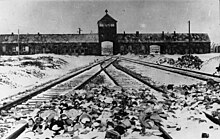
The inadequate post-war order and the depressing economic crisis that resulted in poverty and unemployment promoted the rise of fascism in many European countries . It is a nationalist and totalitarian ideology. The fascist dictatorships negated the individual, created huge armies and pursued an ideology of modernization, which was expressed, for example, in the art of futurism .
The German variety of fascism was National Socialism . Adolf Hitler , the chairman of the National Socialist NSDAP , came to power in 1933 and very quickly established a totalitarian dictatorship. As early as 1933, the rulers developed the term Gleichschaltung , with which they described the complete submission of political, cultural and other public life to their ideology. Political opponents such as social democrats, communists, trade unionists and liberals were persecuted, imprisoned and murdered. In contrast to the Italian origins of fascism, German was also characterized by extreme anti-Semitism , which, with the Holocaust, led to the greatest genocide in human history.
However, the National Socialists also managed to reach the large majority of the German population. With (apparent) social policy measures after the takeover of power , such as the declaration of May 1st as a public holiday and ultimately the term “national socialism ”, they were also able to win over large sections of the workforce. This was supported by a great deal of propaganda and a numbing mass culture that cast a spell over many.
But there was also resistance to the spread of fascism. Between 1936 and 1939, a civil war raged in Spain in which the democratically elected government of the young Spanish republic and its supporters faced the fascist troops of General Francisco Franco . Socialists, communists, anarchists and many others supported the republicans in their struggle, but ultimately lost, also because Nazi Germany provided military support to Franco's troops.
In the German Reich , the resistance was more complicated. The reign of terror of the National Socialists had intimidated many people, and the rulers gained more and more support. Above all, however, the German labor movement has been deeply divided since the Weimar Republic. It was not until long after 1933 that the illegalized KPD abandoned its social fascism thesis, which put social democrats and fascists on a par. The social democrats, who resided in exile in Prague and later in Paris, also found it difficult to establish contact with the communists. The hoped-for united front did not materialize for a long time, despite many efforts. Nevertheless, many resistance cells developed in Germany that worked illegally despite the previously unknown threat of repression. The best-known example of resistance from these circles was the bomb attack on Hitler in 1939 by the Bavarian communist Georg Elser . In addition to the resistance of the labor movement, there was also a bourgeois resistance. The Confessing Church turned against the rulers, groups like the White Rose around Munich's Sophie and Hans Scholl spread appeals against the National Socialists. On July 20, 1944, high-ranking armed forces of the Wehrmacht carried out an assassination attempt on Hitler, which, however, failed.
In 1939, the German Empire finally began with the invasion of Poland, the Second World War . Around 60 million people fell victim to it over the next six years . Over 50 countries entered the war. On May 8, 1945, the war in Europe ended with the surrender of Germany and a devastating balance of victims and destruction.
In the Asia-Pacific region, the war raged for a few more months between the USA and Japan, an ally of Germany, which began with the attack on Pearl Harbor . With the dropping of the atomic bombs on Hiroshima and Nagasaki , this battle reached its climax and at the same time its end.
A new beginning in Europe in 1945
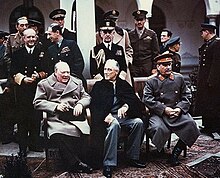
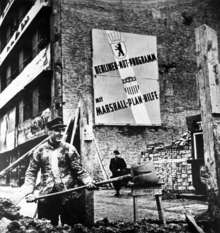
On May 8, 1945 the Wehrmacht unconditionally surrendered and Germany was divided into four zones of occupation . The new superpowers after the end of the war were the USA and the Soviet Union, who faced each other directly in Germany. With the Truman Doctrine , the smoldering conflict broke out openly as the Cold War . Germany became a scene of the clashes. The eastern one reacted to the introduction of the D-Mark in the three western occupation zones by sealing off West Berlin . Two German states soon emerged. On May 23, 1949, the Federal Republic of Germany in the British, French and American occupation zones and a good four months later, on October 7, 1949, the German Democratic Republic . In the Federal Republic of Germany the integration into the sphere of influence of the USA was not an issue. The Soviet Union was also aware of this, which suddenly found itself confronted with the competing superpower at a national border and tried to push for a neutral, united Germany. This policy became concrete with the Stalin Notes of 1952, although its seriousness is still controversial today. The GDR officially gave up the perspective of a united Germany with its new constitution of 1968. The division of Germany was cemented and a massively secured border ran through the country since 1961. Nonetheless, approaches to dialogue were discernible, especially in the 1970s. The Ostpolitik of Willy Brandt sought contact with its eastern neighbors, the CSCE conferences in the 1970s brought both blocks at a table and ultimately much earlier, in 1950, managed an approach to normalizing the traditionally problematic relationship between Germany and Poland by the recognition the Oder-Neisse border .
The long-cherished dreams of the United States of Europe began to concretise for the first time in Western Europe, and the consequences of the war , poverty and the large-scale displacement brought about the first concrete European unification movements . The Schuman Plan of 1950, the founding of the Coal and Steel Community in 1952 and finally the signing of the Treaty of Rome in 1957 were the first steps on this path, which despite all the setbacks led to European integration , from which the EU emerged in its current form in 1993 . The Council of Europe , the European Court of Human Rights , the Western European Union and the European Economic Community were created, and a customs union promoted cross-border cooperation. In the sphere of influence of the Soviet Union, the Council for Mutual Economic Aid ( Comecon , in the West also called Comecon ) was created as a counterpart to the economic mergers of the West .
Since the end of the war, former colonies around the world broke away from their former rulers. In some places this was achieved peacefully, in others the liberation movements had to use violence. What initially concerned primarily directly dependent colonies later expanded to include de facto dependent regimes. In 1979, the regime of the Persian Shah Mohammad Reza Pahlavi was overthrown in the Islamic revolution . The Shah and his dictatorial regime held out mainly because of the strong support from the West. An Islamic republic was installed in its place, which became independent, but in which severe human rights violations continued to prevail.
Third Industrial Revolution and Post-Fordism
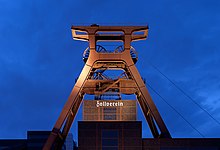
In the 1970s, the key economic data in the industrialized countries outside the Soviet sphere of influence changed noticeably. After the end of the war, material production of goods had increased productivity immensely and brought high rates of profit. Their increase weakened significantly in the 1970s. The third industrial revolution brought computer technology into the production process, and the oil crisis also had a paralyzing effect on industry. The worst economic crises since the end of the war broke out in Europe. Inactivity became a mass phenomenon in many countries. Instead of strong wage increases in the previous decades, which contributed significantly to growth, there were now temporary wage cuts. New jobs emerged, but increasing employment in offices and in the service sector could only insufficiently replace the lost industrial jobs. With this change, which also increasingly included precarious employment , the trade unions were also weakened. Starting with Great Britain under Margaret Thatcher , the political and economic theory of neoliberalism was increasingly implemented. Developed as a reaction to the Great Depression of 1929 and the following years and as a countermovement to the then preferred solution strategy of Keynesianism , it saw the free market as the center of economic policy and thus promised a solution to the problems of post-Fordism . In many places , for example, the privatization of public services , for example through the privatization of railway companies or utilities, should act as an alternative to generating profit for the economy . This policy provoked some fierce opposition from the trade unions and left-wing parties, but they could not prevail. The predominance of this type of policy expanded with the collapse of the Soviet Union, the associated loss of a possible alternative to the system and the disappointment of large circles on the political left.
Collapse of real socialism
When Mikhail Gorbachev, a new general secretary, came to power in the Soviet Union in 1985 , the superpower was already facing major problems. The supply situation became more and more difficult, a problem with which the GDR was also confronted, whose social policy under the Honecker government - such as housing construction and expanding the supply of consumer goods - could not keep up with economic performance. With the politics of perestroika and glasnost , Gorbachev tried to push through social reforms. The increasing freedom of expression in the Soviet Union did not solve the problems, of course. As the Soviet intervention in Afghanistan began to look like a fiasco, the April 26, 1986 Chernobyl nuclear disaster symbolized the failure of the communist system and revealed the general disregard for the interests of the population by the authorities. The Soviet reform policy also met with some fierce rejection in the other Eastern Bloc countries. The GDR leadership stuck to its tried and tested line and even suppressed news from the Soviet Union. For example, in 1988 it took the Soviet magazine Sputnik out of mail distribution, which amounted to a ban because it published an article dealing with the crimes of Stalinism. The opposition in the GDR rose steadily. In the summer of 1989, countless GDR citizens finally took advantage of the opening of the border between Hungary and Austria and fled to the west via Budapest, others sought refuge in the German embassy in Prague . In autumn 1989 people took to the streets in Leipzig for the first time to protest for political reforms at the Monday demonstrations . On November 4th, the largest non-state-organized demonstration in the history of the GDR took place on Alexanderplatz in Berlin . The participants called for a democratic GDR with a plural party system, without state security and an end to incapacitation. A union with the Federal Republic was explicitly rejected. This mood dominated the GDR for five days, until the Berlin Wall and the borders to the Federal Republic were opened on November 9th and tens of thousands of people visited the western part of Berlin that night. The GDR leadership could no longer hold out, members of the Politburo resigned, the leadership was transferred from Honecker to Egon Krenz , but even he was unable to break. After the SED's claim to leadership was erased from the constitution of the GDR, the former state party held a party conference in December against the will of its leadership, which lasted two weekends. It was the first party congress whose delegates were freely elected and where there was free discussion. As a result, the party leadership was completely replaced, the structures changed and the acronym PDS - Party of Democratic Socialism - added to the party name SED. The former state party, which from 1990 onwards called itself PDS, found it difficult to assert itself against the new competition in the following Volkskammer election in 1990 and only came in third place.
After the fall of the Berlin Wall, the call for German unity grew louder. The slogan of the Monday demonstrations We are the people soon became We are one people . After the Volkskammer election, negotiations began between the GDR government and the Federal Republic about the country's accession. In the summer, the D-Mark became the official means of payment in the GDR. As a result, the wide range of goods at prices like those in the West was offset by salaries at GDR level. Many companies that profited from the weak GDR currency and produced inexpensive goods for export were no longer competitive. After the People's Chamber finally resolved to dissolve the GDR and to join the area under the Basic Law, the Unification Treaty was carried out on October 3rd.
The revolutions in 1989 led to the collapse of the real socialist systems in Central and Eastern Europe. Some of these uprisings, such as the Velvet Revolution in Czechoslovakia or the Singing Revolution in the Baltic States, remained peaceful. Others were violent, such as the overthrow of the Romanian dictator Nicolae Ceaușescu , who had distanced himself from the Soviet Union years before and had installed a neo-Stalinist system. The failed August coup in Moscow in 1991 led to the ban on the CPSU and the final collapse of the Soviet Union . The CPSU functionary Boris Yeltsin replaced Mikhail Gorbachev and became President of the new Russian Federation.
New world order
With the fall of the Soviet Union, the phase of bipolarity in the world also ended. The USA was the only remaining world power. The lines of conflict also changed accordingly. While proxy wars were waged during the East-West conflict and the Cold War , in which the two power blocs met through supported third parties, other wars broke out in the last decade of the 20th century. The Gulf War between the USA and Iraq began as early as 1991 under the dictator Saddam Hussein , who years before had been supported by the Americans as an anti-Soviet and anti-Iranian force. Wars followed in the Balkans , where the state of Yugoslavia broke up into its individual states. In Eastern Europe, too, states broke up into their sub-stocks. In the case of the secession of the Baltic States, this only succeeded by force, but no weapon was used when Czechoslovakia was divided into its Czech and Slovak parts. Armed conflicts lost their centers, the era of the great tank battles was just as over as the war between two armies of two states. They were replaced by air strikes and other remotely controlled methods of warfare that were directed against a non-state enemy, mostly organized as a guerrilla.
On the other hand, the European Union has grown steadily since the 1990s. In the new millennium, more and more states of the former Soviet sphere of influence should join it. With the installation of the European community organs , the European internal market became a reality on November 1st, 1993 . The OEEC and EFTA made a large free trade area possible . This was followed by the European Community or the EU and the EU expansion with the Central and Eastern European countries .
Science and technology
natural Science
Albert Einstein developed the special and later the general theory of relativity, as a result of which both the atomic bomb and nuclear power plants were developed. With the establishment of polymer chemistry , the basis for the development of the plastics industry is laid and the triumphant advance of plastics takes its course. Oswald Avery succeeded in identifying deoxyribonucleic acid as a hereditary substance ; its structure is deciphered by Francis Crick and James Watson . This is how genetic engineering is established. Hans Krebs discovered central metabolic reaction cycles such as the citric acid cycle . The architecture of atoms is examined by Ernest Rutherford . Christiaan Barnard performs the first heart transplant . The more than 300 year old Fermatsche conjecture is proven by Andrew Wiles and Richard Taylor . The orthopedic surgeon Gawriil Abramowitsch Ilisarow developed fundamental improvements in orthopedic surgical methods. Through his research on callus distraction , he succeeded in developing the external fixator , making a fundamentally important contribution to osteosynthesis .
Technology and consumption
In the 20th century, technological and electronic devices develop into mass consumer goods such as household appliances, tools, computers , means of communication, media , sound and image reproduction devices as well as means of transport. Mechanical devices are being replaced by digital or electrical innovations in more and more areas; Hygiene, packaging and mobility are gaining in importance.
The combustion engine and electricity are increasingly replacing the steam engine for driving rail and water vehicles. Individual road traffic is gaining dominance over rail traffic, which has a significant impact on urban planning. Air traffic is emerging and is developing into scheduled service. Global long-distance passenger transport will soon be handled almost exclusively by air. High-speed trains are emerging in rail transport, and tankers and container ships in global merchant shipping.
Space travel
On June 4, 1944, an aggregate 4 (V2) rocket, the first human-constructed object, broke the boundary with space ( the Kármán line, as defined by the FAI, at an altitude of more than 100 km ). On October 4, 1957, Sputnik 1, the first artificial earth satellite was launched - the beginning of space travel. In the same year, on November 3rd, the dog Laika was the first living creature to be carried into space. Yuri Gagarin succeeded on April 12, 1961 with the help of Vostok 1 to carry out the first orbit of the earth. In the Mission Voskhod 2 , 1965, succeeded the first spacewalk by Alexei Leonov . Three years later, on December 21st, the Apollo 8 mission completed the first manned orbit around the moon . On July 20, 1969, Apollo 11 landed together with Neil Armstrong as the first person on the moon.
The Apollo 17 started the last manned flight to the moon on December 7, 1972. In 1977 the Voyager 1 and Voyager 2 were the first probes to be sent out that contained a gold data plate with images of the earth.
At 51 Pegasi b , the first planet outside of our solar system was discovered in 1995. In 1998 the project of the International Space Station ISS began .
art
Visual arts
The visual arts of the 20th century were shaped by the avant-garde and styles such as modernism , cubism , pop art and surrealism . Outstanding protagonists were Salvador Dalí , Pablo Picasso and Max Beckmann .
music



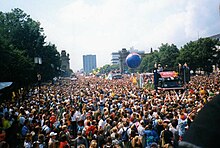
The 19th century passed with tendencies that slowly dissolved the well-known European musical culture. Franz Liszt and his son-in-law Richard Wagner experimented with new harmonies, Claude Debussy received Wagner, allowed himself to be influenced by Far Eastern pentatonic scales and transformed impressionist painting into music with the same name . Everyone was affected by the economic developments. As early as the end of the 19th century, Wagner wrote about the economization of art, in which it becomes a commodity - certainly without using the Marxian term. In the course of the 20th century, economic, political and social developments were linked with art in many places. The period of atonal music was followed by the twelve-tone music of the Austrian composer Arnold Schönberg . Schönberg deleted all the hierarchies of tones from the music and replaced them with all 12 tones that functioned equally in one piece.
European fascism also had profound effects on the development of music. Modernism, which had already developed in the 1930s, was branded as “degenerate” or “Jewish-Bolshevik”; most composers and musicians had to flee into exile. The National Socialists in particular replaced them with conservative tones, such as that of Hans Pfitzner , who was still arrested in the late Romantic period . The repressive and backward-looking cultural policy of the Nazis severely affected European musical life and prevented 1945 from being able to keep pace with developments.
In the Soviet Union and its later satellite states, state-influenced music developed completely differently. Although the rulers installed the ideology of Socialist Realism , this term remained vague. Twelve-tone music was regarded as "bourgeois-decadent", but when Hanns Eisler experimented with it and composed seriously, it quietly entered the canon of socialist realism. A rich musical life also developed in the Soviet Union, which, especially during the Stalinist era, constantly oscillated between adaptation and persecution. Sergei Prokofiev and especially Dmitrii Shostakovich moved constantly between the poles of highest distinction and the fear of arrest. Nevertheless, her works are among the most important in art music of the 20th century.
Even in the western world, making music was not disconnected from politics. In the 1960s and 1970s, in the context of the 1968 movement and subsequent social movements, for example against the Vietnam War , many artists functioned as political actors. In Italy in particular, three names from art music became known for this committed music : the composer Luigi Nono , the conductor Claudio Abbado and the pianist Maurizio Pollini . In Germany, too, an important representative of art music acted with Hans Werner Henze , who positioned himself on the political events of the time, but left the country, which was perceived as oppressive, for Italy in the 1950s.
Stylistically, the post-war period was shaped by serial music , the use of synthesizers and other electronic stylistic devices. These spread to popular music with a delay of decades.
The 20th century was mainly characterized by the rise of popular music. Ragtime came to Europe from the USA at the beginning of the century and, especially after the First World War, jazz spread throughout European cities. The multitude of entertainment venues made it possible. After the Second World War, American occupation troops brought the swing to Germany, which was banned during the Nazi regime. Later rock 'n' roll spread and met with stiff resistance from conservative German society. Similar to beat music , it became the expression of a rebellious new generation.
These intergenerational relationships became clearer again in the years after 1990, when a new direction in electronic music emerged , especially in Berlin . Techno stood for a new hedonism that the new world order brought about after the collapse of the Soviet Union and the end of the block dispute, and it shaped an entire generation of young people.
Movie
The 20th century was the century of film. The first documented showing of a silent film took place in Berlin in 1895 . In the following three decades this blossomed. As early as World War I, films were an important part of the propaganda, they brought the new threatening tanks to the home front and contributed to the fact that the military like Paul von Hindenburg were stylized into war heroes. In Germany, the world's most important film center at times was created in Berlin-Weißensee . Classics such as The Cabinet of Dr. Caligari , Nosferatu - A Symphony of Horror or Metropolis . Very soon, however, serious competition developed in Hollywood , California , where the largest collection of film studios in the western world was to arise in the course of the 20th century.
After the sound film slowly gained acceptance around 1930 , Hollywood finally rose to become the leading “film power”. During the Second World War, the film played an immense role in the propaganda of the warring parties. The best-known and outstanding example of this type of film is The Great Dictator, with Charlie Chaplin as director and in several leading roles, including the figure of the Hitler-based, ridiculed Anton Hynkel.
After the war, film history in Germany also split. In the West, mostly inconsequential entertainment and homeland films were produced for decades . The recent past has been explicitly ignored. It was not until the 1970s that German cinema slowly regained importance. In the GDR, on the other hand, DEFA was a high-quality film producer who produced a whole series of auteur films and, above all, works that dealt with the Nazi past. However, films were also made whose approach did not correspond to the ideas of the political leadership. The film Spur der Steine, for example, with Manfred Krug in the lead role, was removed from the program three days after its premiere in 1966 and shown again in the GDR in 1989. A number of other films shared this fate.
Sports
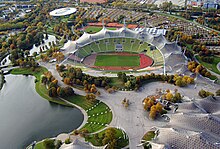
In the 20th century, many sports were professionalized and globally recognized sporting events were established that were repeated at regular intervals, such as world and continental championships in many sports, the Summer and Winter Olympic Games and others. Through mass media coverage and public attention, top athletes generated incomes that allowed them to make a living and which allowed them to focus full-time on their sport. Later in the century, the incomes of outstanding athletes in individual sports grew to the salaries of the upper class. Sports that have increasingly generated such income include: a. American football , basketball , baseball , ice hockey , cycling , tennis , golf , automotive, and soccer . In the latter, internationally organized professional leagues established themselves, also in Germany, Austria and Switzerland. With the possibility of making significant profits through sport, corresponding manipulation techniques also emerged, for example doping or the Bundesliga scandal in Germany .
See also
- 100 words of the century
- Bibliothèque de documentation internationale contemporaine (BDIC)
- Short 20th century
literature
- Eric Hobsbawm : The Age of Extremes. World history of the 20th century. Hanser, Munich, Vienna 1995, ISBN 3-446-16021-3 .
- Dan Diner : Understanding the Century. A universal historical interpretation. , Fischer Taschenbuch Verlag, Frankfurt 2000, ISBN 3-596-14766-2 .
- Mark Mazower : The Dark Continent. Europe in the 20th century . Berlin 2000.
- Hans-Heinrich Nolte : World history of the 20th century . Böhlau, Vienna 2009, ISBN 978-3-205-78402-9 .
-
Heinrich August Winkler : History of the West . 4 volumes. Beck, Munich 2009–2015:
- From the beginnings in antiquity to the 20th century . 2009 (3rd edition 2012), ISBN 978-3-406-59235-5 .
- The time of the world wars 1914–1945 . 2011, ISBN 978-3-406-59236-2 .
- From the Cold War to the fall of the Berlin Wall . 2014, ISBN 978-3-406-66984-2 .
- The time of the present . 2015, ISBN 978-3-406-66986-6 .
Web links
100 (0) key documents to German history in the 20th century . In: 1000dokumente.de



